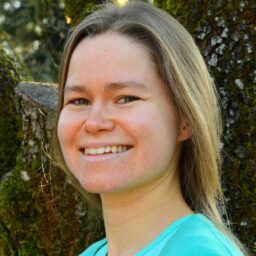
Hannah Larson Wins Hertz Thesis Prize for Updating Fundamental Mathematical Theory
Coming up with mathematical equations to describe basic circles or parabolas is something anyone who has taken an algebra class might be able to achieve. But it takes advanced mathematical theories to describe more complex and abstract curves — imagine a tangled piece of yarn suspended in gravity-free space, curlicuing in dozens of loops.
Hannah Larson, a 2017 Hertz Fellow, has now expanded a long-standing mathematical theory to better map out these kinds of complex curves — and even more abstract ones. Understanding what curves exist could have important applications in other areas of mathematics as well as physics, data science and computation.
Larson’s work, part of her Stanford University thesis, “Brill–Noether theory over the Hurwitz space,” was awarded the 2022 Hertz Thesis Prize from the Hertz Foundation. The Thesis Prize recognizes fellows with exemplary, transformative doctoral theses, and Larson joins more than 60 fellows who have been previously recognized with the award. Winners are chosen by a vibrant and committed group of volunteers, consisting of previous Hertz Fellows, who serve as Thesis Reviewers on the Hertz Prize Committee. Larson’s thesis was chosen for its paradigm-shifting implications in the field of algebraic geometry— the study of geometric objects that can be defined by polynomial equations.
“The classical Brill-Noether theorem, which was proved in the 1980s, doesn’t hold true for all curves,” said Larson, who carried out her research under the mentorship of Stanford Professor of Mathematics Ravi Vakil. “I studied particular curves where the theorem failed in order to build a more complete picture of what sorts of curves exist in different spaces.”
Just as biologists make catalogues of species, mathematicians try to catalogue curves. Historically, mathematicians considered curves as existing in a particular space. But in the 1850s, people in the field began to think about abstract curves, which might not exist in any particular space, but map into different spaces in different ways. This breaks the problem of describing curves into two pieces: first, the classification of abstract curves and then the mapping of these curves to different spaces. The second part is known as Brill—Noether theory, named after two German mathematicians who made a formative conjecture in 1874.
Larson grew up in Eugene, Oregon and became fascinated with algebraic geometry during an undergraduate class at Harvard University. She decided to devote her undergraduate senior thesis to the topic, studying under Harvard mathematician Joe Harris. Her initial work focused on the properties of lines on surfaces and other shapes.
“There were some unresolved questions about that work,” Larson says. “And I started chatting with a friend about new ways to think about those questions. It became clear that these ideas could also be used to solve new problems in Brill-Noether theory.”
Larson says the key to her work was developing a new “invariant” or property to describe the way that a curve maps to a space. Invariants are values that describe unchanging properties; an invariant of a square, for instance, is its area. If the square is rotated or reflected, its area won’t change. For general curves, there were already two invariants describing their maps: the dimension of the space and the degree— essentially how “curvy” the curve is.
“I discovered a new invariant called the ‘splitting type’ for these sorts of special curves,” says Larson. “The splitting type actually contains both the degree and dimension within it. It looks harder to study because it has more information within it, but it turns out to make the problem of these special curves much simpler.”
Having a Hertz Fellowship, Larson added, gave her flexibility and time to dive into her mathematical thinking that she might not otherwise have had. “The fellowship really meant a lot,” she says.
Last year, after finishing her work at Stanford, Larson returned to Harvard as a junior fellow at the Harvard Society of Fellows and Clay Research Fellow. This fall, she will join the faculty at the University of California, Berkeley, as an assistant professor. She plans to continue studying the same kind of curves that she probed in her thesis.
“What I’ve been working on so far is describing what curves exist in a certain space,” says Larson. “Now that we know what curves exist, my colleagues and I are asking qualitative questions like: What do these curves actually look like?”
